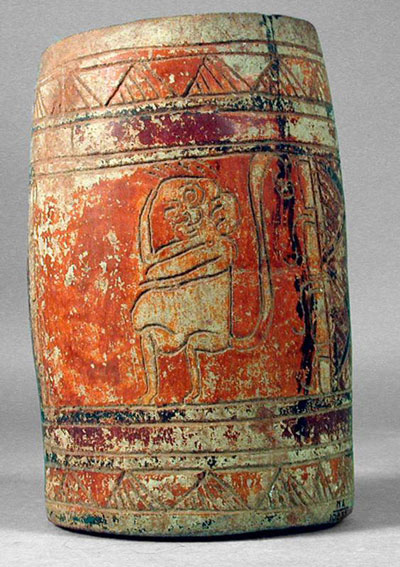
Caves in the Alta Verapaz region of Guatemala were frequently used for rituals and burials by the ancient Maya. This cylindrical vessel comes from a cave near the village of Senahú, where it was collected by Robert Burkitt during the early 20th century. Although Burkitt called it a burial cave, his usually meticulous notes do not reveal whether this cylinder was part of the burial or its accompanying ritual. When he visited the cave, its contents were so badly disturbed he could not determine the original location of any of the objects.
This vessel—part of the Museum’s recent pottery conservation project funded by the Getty Grant Program—was sampled for residue analysis by W. Jeffrey Hurst, Senior Staff Scientist at Hershey Foods Technical Center. Traces of both theobromine and caffeine provided evidence that it once contained chocolate. Despite its poorly formed shape and crudely incised decoration, this vessel once held a beverage reserved for rituals and elite feasts.
The figure on it is an accurate approximation of a spider monkey, with hands like hooks, long narrow palms, long curved fingers, and no thumb. Although they rarely descend to the ground, spider monkeys can walk on two legs with their prehensile tail curved parallel to their back exactly like the tail on this figure.
Monkeys figure frequently in Maya art and folklore. For example, the Maya creation myth, the Popol Vuh, tells of early, unsuccessful attempts to create humans from things other than corn. After the creator gods failed to form people out of mud, they tried making them of wood, but the behavior of these ‘humans’ was so inappropriate that the gods changed them into monkeys as punishment. This theme also appears in the Popol Vuh when the older half-brothers of the Hero Twins are transformed into monkeys as punishment for their behavior toward their younger siblings.
Monkeys, however, were also portrayed as scribes, artists, sculptors, musicians, and patrons of the arts. They are reflections of ourselves, not quite human, yet illustrating some of the best and worst human traits. They are mirrors of human behavior, associated with excesses of pleasure, intoxication, gluttony, and lascivious behavior.
Our similarities also include a love of chocolate. Spider monkeys love it and are known to raid cacao trees and eat the fruit before it ripens. While the figure on the vessel may hark back to an arcane ritual, its choice as decoration may symbolize nothing more than the love for chocolate shared by both humans and monkeys.
ELIN C. DANIEN is a Research Associate in the Museum’s American Section.
